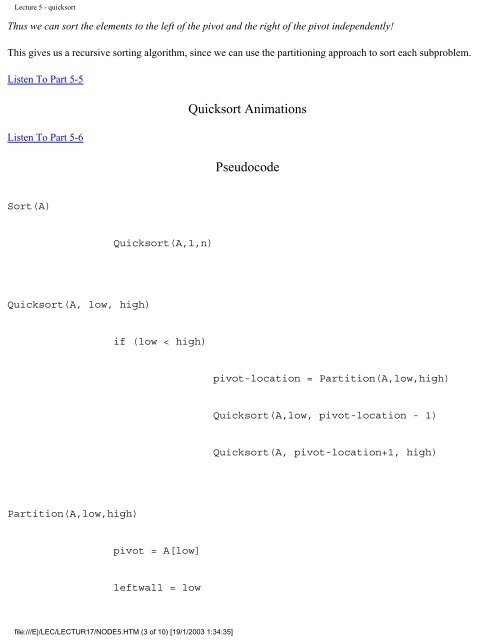The.Algorithm.Design.Manual.Springer-Verlag.1998
The.Algorithm.Design.Manual.Springer-Verlag.1998 The.Algorithm.Design.Manual.Springer-Verlag.1998
Lecture 5 - quicksort Thus we can sort the elements to the left of the pivot and the right of the pivot independently! This gives us a recursive sorting algorithm, since we can use the partitioning approach to sort each subproblem. Listen To Part 5-5 Listen To Part 5-6 Sort(A) Quicksort(A, low, high) Partition(A,low,high) Quicksort(A,1,n) if (low < high) pivot = A[low] leftwall = low file:///E|/LEC/LECTUR17/NODE5.HTM (3 of 10) [19/1/2003 1:34:35] Quicksort Animations Pseudocode pivot-location = Partition(A,low,high) Quicksort(A,low, pivot-location - 1) Quicksort(A, pivot-location+1, high)
Lecture 5 - quicksort Listen To Part 5-7 for i = low+1 to high swap(A[low],A[leftwall]) if (A[i] < pivot) then Best Case for Quicksort leftwall = leftwall+1 swap(A[i],A[leftwall]) Since each element ultimately ends up in the correct position, the algorithm correctly sorts. But how long does it take? The best case for divide-and-conquer algorithms comes when we split the input as evenly as possible. Thus in the best case, each subproblem is of size n/2. The partition step on each subproblem is linear in its size. Thus the total effort in partitioning the problems of size is O(n). The recursion tree for the best case looks like this: The total partitioning on each level is O(n), and it take levels of perfect partitions to get to single element subproblems. When we are down to single elements, the problems are sorted. Thus the total time in the best case is . Listen To Part 5-8 file:///E|/LEC/LECTUR17/NODE5.HTM (4 of 10) [19/1/2003 1:34:35]
- Page 837 and 838: Binary Search in Action file:///E|/
- Page 839 and 840: Binary Search in Action file:///E|/
- Page 841 and 842: Postscript version of the lecture n
- Page 843 and 844: Lecture 1 - analyzing algorithms Ne
- Page 845 and 846: Lecture 1 - analyzing algorithms Yo
- Page 847 and 848: Lecture 1 - analyzing algorithms Th
- Page 849 and 850: Lecture 1 - analyzing algorithms Th
- Page 851 and 852: Lecture 1 - analyzing algorithms is
- Page 853 and 854: Lecture 2 - asymptotic notation How
- Page 855 and 856: Lecture 2 - asymptotic notation Not
- Page 857 and 858: Lecture 2 - asymptotic notation alg
- Page 859 and 860: Lecture 2 - asymptotic notation Sup
- Page 861 and 862: Lecture 2 - asymptotic notation Nex
- Page 863 and 864: Lecture 3 - recurrence relations Is
- Page 865 and 866: Lecture 3 - recurrence relations
- Page 867 and 868: Lecture 3 - recurrence relations Li
- Page 869 and 870: Lecture 3 - recurrence relations Su
- Page 871 and 872: Lecture 3 - recurrence relations A
- Page 873 and 874: Lecture 4 - heapsort Note iteration
- Page 875 and 876: Lecture 4 - heapsort The convex hul
- Page 877 and 878: Lecture 4 - heapsort 1. All leaves
- Page 879 and 880: Lecture 4 - heapsort left = 2i righ
- Page 881 and 882: Lecture 4 - heapsort Since this sum
- Page 883 and 884: Lecture 4 - heapsort Selection sort
- Page 885 and 886: Lecture 4 - heapsort Greedy Algorit
- Page 887: Lecture 5 - quicksort Partitioning
- Page 891 and 892: Lecture 5 - quicksort Listen To Par
- Page 893 and 894: Lecture 5 - quicksort The worst cas
- Page 895 and 896: Lecture 5 - quicksort Mon Jun 2 09:
- Page 897 and 898: Lecture 6 - linear sorting Since 2i
- Page 899 and 900: Lecture 6 - linear sorting With uni
- Page 901 and 902: Lecture 6 - linear sorting Listen T
- Page 903 and 904: Lecture 7 - elementary data structu
- Page 905 and 906: Lecture 7 - elementary data structu
- Page 907 and 908: Lecture 7 - elementary data structu
- Page 909 and 910: Lecture 7 - elementary data structu
- Page 911 and 912: Lecture 7 - elementary data structu
- Page 913 and 914: Lecture 7 - elementary data structu
- Page 915 and 916: Lecture 7 - elementary data structu
- Page 917 and 918: Lecture 8 - binary trees - Joyce Ki
- Page 919 and 920: Lecture 8 - binary trees TREE-MINIM
- Page 921 and 922: Lecture 8 - binary trees Inorder-Tr
- Page 923 and 924: Lecture 8 - binary trees Listen To
- Page 925 and 926: Lecture 8 - binary trees insert(b)
- Page 927 and 928: Lecture 8 - binary trees Not (1) -
- Page 929 and 930: Lecture 9 - catch up Next: Lecture
- Page 931 and 932: Lecture 10 - tree restructuring 1.
- Page 933 and 934: Lecture 10 - tree restructuring Lis
- Page 935 and 936: Lecture 10 - tree restructuring Not
- Page 937 and 938: Lecture 10 - tree restructuring Cas
Lecture 5 - quicksort<br />
Thus we can sort the elements to the left of the pivot and the right of the pivot independently!<br />
This gives us a recursive sorting algorithm, since we can use the partitioning approach to sort each subproblem.<br />
Listen To Part 5-5<br />
Listen To Part 5-6<br />
Sort(A)<br />
Quicksort(A, low, high)<br />
Partition(A,low,high)<br />
Quicksort(A,1,n)<br />
if (low < high)<br />
pivot = A[low]<br />
leftwall = low<br />
file:///E|/LEC/LECTUR17/NODE5.HTM (3 of 10) [19/1/2003 1:34:35]<br />
Quicksort Animations<br />
Pseudocode<br />
pivot-location = Partition(A,low,high)<br />
Quicksort(A,low, pivot-location - 1)<br />
Quicksort(A, pivot-location+1, high)



